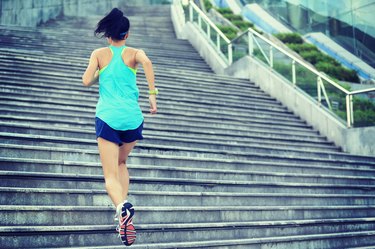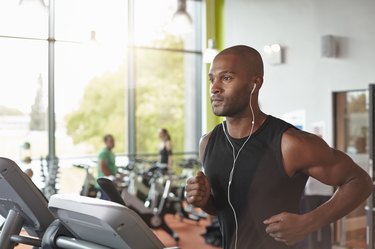
While you can't really trick your body into burning fat, there are some small things you can do to help trigger a little more fat loss — some that are actually pretty surprising.
Of course, proper nutrition, calorie intake and physical activity are the biggest factors when it comes to weight loss. But did you know that chewing gum, grabbing a coffee and listening to music can all help boost your overall calorie burn?
Video of the Day
Video of the Day
Keep reading to learn about 10 surprising ways to burn more fat and calories each day.
1. Drink Ice Water
Drinking water at any temperature is not only a necessity, but also very beneficial for your body. You should be aiming for somewhere between 11 and 16 cups each day, according to the Mayo Clinic.
Here's what's surprising: When you drink one cup of ice water, according to the University of Washington, you'll burn 8 more calories than if the water was at room temp. This happens because your body works a little harder to bring the water temperature up to normal body temperature.
So, 10 cups would give you 80 extra calories, which is pretty marginal in the grand scheme of calorie counting. But, if you're the "every little bit counts" type, then add those ice cubes and get to drinking.
As a bonus, drinking water helps you feel full, which may prevent snacking and overeating, according to an August 2015 study in Obesity.
2. Chew Gum After Meals
Remember when chewing gum wasn't really recommended? Well, now the tune has changed.
A small April 2016 study in Obesity showed that diet-induced thermogenesis was much greater in those who chewed gum after a meal.
Similarly, a January 2018 study in The Journal of Physical Therapy Science concluded that those who walked and chewed gum had an elevated heart rate as well as a higher energy expenditure than those who did not chew gum.
Not convinced? Gum was also shown to increase the feeling of satiety after a meal in a small study published March 2016 in Physiology and Behavior. It may also reduce high-carb snacking in between meals.
3. Chew Your Food Slowly
Isn't that what your mom always said? "Go slow and chew your food!" She wasn't wrong.
Eating slowly is an effective way to control your appetite, according to a December 2021 article in Nature's Scientific Reports. Not only that, but (this is the good part) slower chewing can increase post-meal diet-induced thermogenesis (calorie burning) due to oral stimuli. That's why the authors note it's effective way to help prevent obesity.
Chewing food slowly can also help you feel fuller longer. A small December 2018 study in Nutrients found people who ate slowly had a greater increase in satiety after their meal and also snacked less during the day.
4. Exercise to Music
There's nothing like a great playlist to get you going… and get you burning. So are you really that surprised that your favorite music makes you work harder when it comes to physical activity?
A small May 2015 study in Medicine and Science in Sport Exercise had 20 people complete sprint intervals with and without music. It was found that music enhanced their performance as well as their enjoyment while working out.
Another small study, in the March 2020 issue of The Journal of Sports Medicine and Physical Fitness, tested 15 healthy adults while doing anaerobic exercise, with and without music. There was a significant increase in their overall physical output while working out to the music of their choice.
It's a no-brainer that music can push you to work harder and maybe even for a longer period of time, burning more calories and building more muscle. So, get some great headphones, hit play and move that body.
5. Cool Down
For many, winter is a good time to bundle up and get cozy. But what if you found out that cold temps could help burn fat?
Well, a small July 2013 study in The Journal of Clinical Endocrinology and Metabolism tested 31 volunteers in 75-degrees and 66-degrees Fahrenheit conditions and found that 24 of the participants had an increased energy expenditure when going from warm to colder conditions.
So, who's ready to ditch those jackets?
6. Get a Caffeine Boost
Certain foods and substances are thought to have more of a thermic effect than others. In other words, they may help the body burn more calories. One of those is caffeine, according to an April 2020 article in Nutrients.
This thermic effect can last about 150 minutes after a single-dose caffeine ingestion. But keep in mind that people who normally have a high caffeine intake may become desensitized to this effect.
In another small January 2020 study from the Harvard T.H. Chan School of Public Health, researchers found that people with overweight who drank four cups of coffee each day saw a 4 percent reduction in body fat. They theorized that the caffeine helped them burn more calories by increasing their metabolism.
7. Move More
Any activity you do throughout the day that isn't actually exercise is called nonexercise activity thermogenesis (NEAT) and can burn approximately 100 to 800 extra calories daily, according to the Mayo Clinic. Fidgeting at your desk, walking from room to room, gardening, playing with your kids, etc., will help burn more fat than if you were just sedentary all day.
Now, imagine cleaning your house with your favorite music blasting…hello, calorie burn.
Related Reading
8. Lift Weights
OK, this might not be as surprising as the others, but lifting weights and strength/resistance training still comes in second to cardio to a lot of people. In reality, though, strength training should be just as important as cardio on your priority list, because having more muscle mass increases your metabolic rate, according to the American Council on Exercise.
An April 2014 study in the Journal of Sports Sciences found that cardio combined with strength training produced better results — decreased body fat and increased lean muscle — than just cardio alone.
Indeed, you could potentially raise your resting metabolic rate by 7 percent doing 10 weeks of resistance training, per an article published in the July/August 2012 issue of Current Sports Medicine Reports.
9. Add Cardio Bursts
When it's just an all-cardio day, trying adding some intervals to it — short bursts of high intensity. So, for example, if you're jogging on the treadmill at 4 mph, pump it up to 5 mph every few minutes, for 30 seconds to a minute, then go back to 4 mph. This is a type of HIIT (high-intensity interval training) workout.
These type of workouts, according to the American College of Sports Medicine, will burn more calories than a steady-paced workout, especially afterward. The post-exercise period is called EPOC — excess post-exercise oxygen consumption. This is approximately a two-hour period after your workout where the body is working to get back to normal, using energy to do so.
Adding cardio boosts during your workout is also more time efficient, improves your fitness, cardiovascular health and blood pressure, and could make your workout a little more exciting. If you think about it, you could add little boosts to any type of workout — just do what you love.
"Exercise is the best route to burning fat and calories," says dietitian Bonnie Taub-Dix, RDN, CDN. "Exercises like walking, jogging, cycling, swimming and other aerobic activities can help you lose or control weight. What's best is to find an activity that you enjoy, like dancing, so that you can have fun while moving your body for the best benefits."
Related Reading
10. Eat
Saved the best for last! When the goal is to burn more fat, most people tend to focus on calorie reduction and what they shouldn't eat. However, eating an enjoyable, balanced diet is essential for proper body function as well as inducing fat burn (remember diet-induced thermogenesis?).
While you should limit your intake of sugar and unhealthy fats, you should up your lean protein, whole grains, fruits, veggies and healthy fats, according to the Mayo Clinic.
"Many people don't realize that you actually have to eat to lose weight and body fat," Taub-Dix says. "Some people cut their calories too low, and this causes the body to conserve energy and actually keep you from losing weight. It's kind of a way the body protects itself."
The Safest Ways to Burn Fat
It's important to understand that you can't just chew gum in the cold while drinking iced coffee to burn the fat you may be looking to lose. You need to put in the work — proper nutrition and physical activity are the keys to sustainable fat loss. The surprising ways to burn fat above are just little things that may help you along the way. To burn fat and lose unwanted weight, The U.S. Department of Agriculture suggests:
- A reduced-calorie, nutritionally balanced eating plan
- Consistent physical activity (remember to mix cardio and weights!)
- Behavior changes to keep your body in determined, fat-burning mode
Ready to Lose Weight?
Set yourself up for success with LIVESTRONG.com's Weight-Loss Kickstart program.
- Mayo Clinic: "Water: How Much Should You Drink Every Day?"
- University of Washington: "Mythbusters: Will Drinking Water Help With…?"
- Obesity: "Effect of PostPrandial Gum Chewing on Diet-Induced Thermogenesis"
- The Journal of Physical Therapy Science: "The Effects of Gum Chewing While Walking on Physical and Physiological Functions"
- Physiology and Behavior: "Short-Term Effects of Chewing Gum on Satiety and Afternoon Snack Intake in Healthy Weight and Obese Women"
- Scientific Reports: "Chewing Increases Postprandial Diet-Induced Thermogenesis"
- Nutrients: "Slow Down: Behavioural and Physiological Effects of Reducing Eating Rate"
- Nutrients: "The Health Impact of Nighttime Eating: Old and New Perspectives
- Academy of Nutrition and Dietetics: "5 Tips to Curb Your Late-Night Snacking"
- Medicine and Science in Sport Exercise: "Music Enhances Performance and Perceived Enjoyment of Sprint Interval Exercise"
- The Journal of Sports Medicine and Physical Fitness: "The Effect of Music on Anaerobic Exercise Performance and Muscular Endurance"
- Mayo Clinic: "Metabolism and Weight Loss: How You Burn Calories"
- The Journal of Clinical Endocrinology and Metabolism: "Brown Fat Activation Mediates Cold-Induced Thermogenesis in Adult Humans in Response to a Mild Decrease in Ambient Temperature"
- American Council on Exercise: "Trimming Off the Fat"
- Journal of Sports Sciences: Aerobic Plus Resistance Training Was More Effective in Improving the Visceral Adiposity, Metabolic Profile and Inflammatory Markers Than Aerobic Training in Obese Adolescents"
- Current Sports Medicine Report: "Resistance Training is Medicine: Effects of Strength Training on Health"
- American College of Sports Medicine: "High-Intensity Interval Training"
- Mayo Clinic: "Can I Boost My Metabolism to Lose Weight?"
- U.S. Department of Agriculture: "Interested in Losing Weight?"
- Obesity: "Efficacy of water preloading before main meals as a strategy for weight loss in primary care patients with obesity: RCT"
- Harvard T.H. Chan School of Public Health: "Four cups of coffee a day associated with modest loss of body fat"


